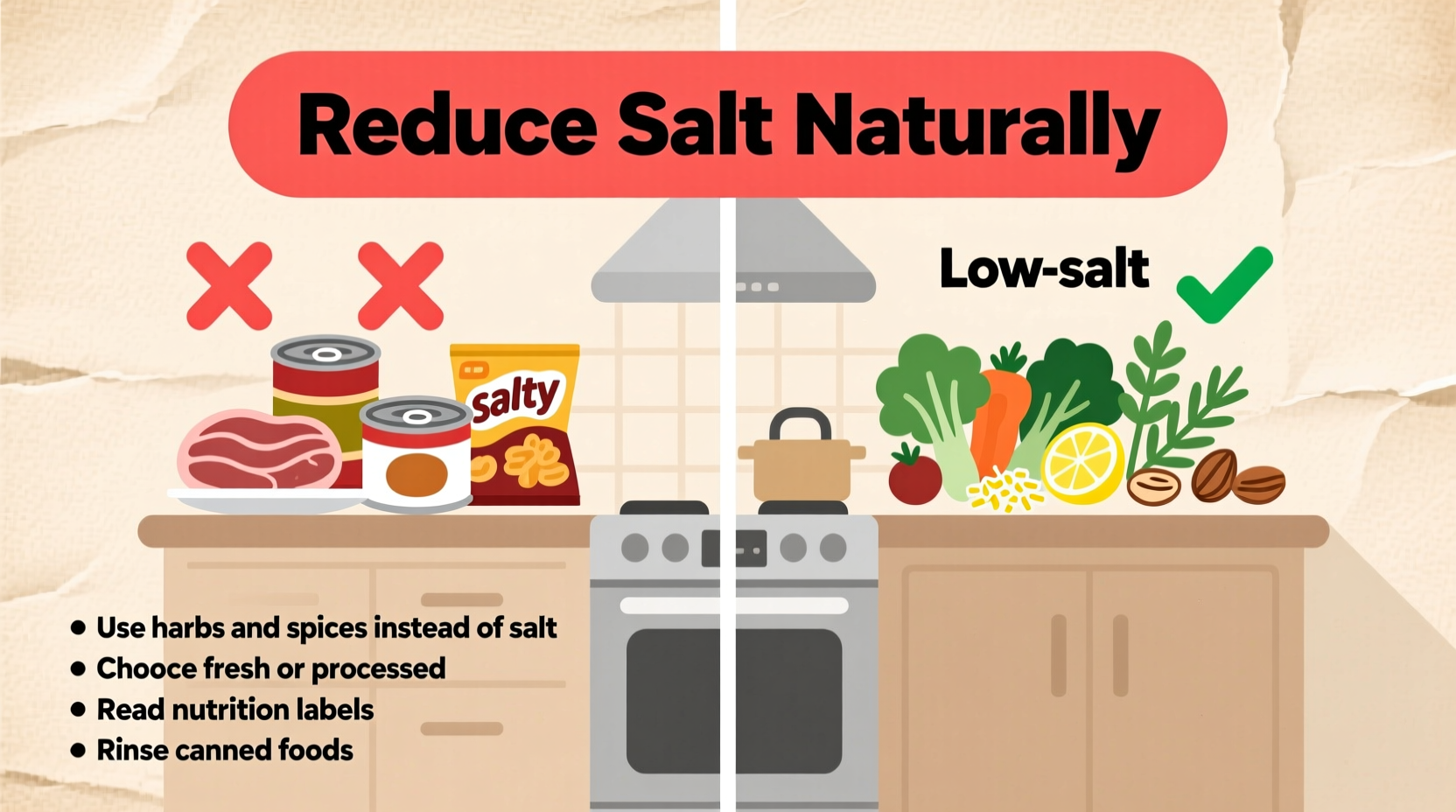Reducing salt in your food is achievable through strategic ingredient substitutions and cooking techniques that enhance natural flavors. According to the American Heart Association, adults should consume no more than 2,300 mg of sodium daily, with an ideal limit of 1,500 mg for most adults—yet the average American consumes over 3,400 mg daily. Implementing these evidence-based methods helps lower blood pressure and reduces cardiovascular disease risk within weeks.
Why Your Taste Buds Need This Salt Reduction Roadmap
Many home cooks mistakenly believe reducing salt means bland food. The truth? Your palate adapts remarkably fast. Research from the Monell Chemical Senses Center shows taste sensitivity to salt increases by 30% within 4-8 weeks of reduced sodium intake. This biological adaptation means foods you once found adequately seasoned will eventually taste overly salty—making healthy eating progressively more enjoyable.
Strategic Salt Reduction by Cooking Phase
Meal Planning & Grocery Shopping
Start your salt reduction journey before you even enter the kitchen. Processed foods contribute 70% of dietary sodium according to CDC data. When meal planning:
- Choose fresh or frozen vegetables instead of canned varieties
- Select "no salt added" or "low sodium" versions of broths and sauces
- Plan meals around naturally low-sodium protein sources like fish and legumes
- Create a spice inventory checklist to avoid impulse salt-heavy purchases
Food Preparation Techniques
How you handle ingredients significantly impacts final sodium content:
- Rinse canned goods thoroughly—reduces sodium by up to 41% (Journal of Food Science)
- Soak salted meats like ham or bacon in cold water for 30 minutes before cooking
- Use acid strategically—lemon juice or vinegar brightens flavors without salt
- Layer flavors gradually rather than adding salt at the end
| Common Food | Regular Version (mg sodium) | Low-Sodium Alternative (mg sodium) | Sodium Reduction |
|---|---|---|---|
| Chicken broth (1 cup) | 800-1,200 | 140-200 | 75-85% |
| Canned tomatoes (1 cup) | 400-600 | 25-50 | 90-95% |
| Soy sauce (1 tbsp) | 900-1,000 | 450-500 | 50% |
| Cottage cheese (1/2 cup) | 450-500 | 150-200 | 60-70% |
Natural Flavor Enhancement System
Professional chefs use these scientifically validated flavor boosters instead of salt:

Umami Powerhouses
Mushroom powder, tomato paste, and nutritional yeast provide deep savory notes. A 2022 study in Food Quality and Preference found that adding 1 teaspoon of mushroom powder to dishes allowed for 35% salt reduction while maintaining perceived flavor intensity.
Acid Activation
Lemon, lime, and vinegar don't just add tartness—they trigger saliva production which enhances overall flavor perception. Try finishing dishes with a squeeze of citrus rather than adding salt during cooking.
Aromatic Foundations
Sauté onions, garlic, and celery in olive oil before adding other ingredients. This "holy trinity" of aromatics creates complex flavor compounds through the Maillard reaction, reducing the need for salt by up to 40% according to culinary research.
Taste Bud Retraining Protocol
Implement this evidence-based adaptation timeline to make low-sodium eating enjoyable:
| Week | Strategy | Expected Taste Change | Implementation Tip |
|---|---|---|---|
| 1 | Reduce salt by 25% | Foods may taste bland initially | Use extra herbs and lemon juice |
| 2 | Reduce salt by 40% | Notice subtle flavors emerging | Try one new spice blend daily |
| 3 | Reduce salt by 60% | Previously normal foods taste salty | Compare two versions of same dish |
| 4 | Reduce salt by 75% | Enhanced flavor appreciation | Host a salt-reduced dinner party |
Context-Specific Salt Reduction Guidelines
Different cooking scenarios require tailored approaches:
- For soups and stews: Add salt at the end rather than beginning—liquid reduction concentrates sodium
- When baking: Reduce salt by 25% without affecting texture; use citrus zest for flavor enhancement
- With meats: Create herb crusts instead of salt rubs; use mushroom-based marinades
- For pickling: Substitute 25% of salt with citric acid to maintain preservation properties
Your 4-Week Salt Reduction Action Plan
Implement these manageable steps for sustainable results:
- Week 1: Replace one high-sodium pantry item with a low-sodium alternative
- Week 2: Implement the "rinse rule" for all canned goods
- Week 3: Experiment with one new salt-free seasoning blend daily
- Week 4: Cook one meal completely without added salt
This gradual approach prevents flavor shock and allows your taste buds to adapt naturally. The National Institutes of Health reports that consistent implementation of these techniques reduces systolic blood pressure by 5-8 mmHg within 6 weeks—comparable to some medication effects.
Common Salt Reduction Mistakes to Avoid
Many well-intentioned cooks undermine their efforts through these common errors:
- Over-relying on salt substitutes: Potassium chloride-based substitutes can have metallic aftertastes and aren't suitable for kidney disease patients
- Adding salt too early: Salt added at the beginning of cooking penetrates ingredients more deeply than salt added at the end
- Neglecting hidden sodium: Check labels on unexpected items like bread, cereal, and yogurt
- Expecting immediate results: Taste adaptation requires consistent effort over weeks, not days











 浙公网安备
33010002000092号
浙公网安备
33010002000092号 浙B2-20120091-4
浙B2-20120091-4